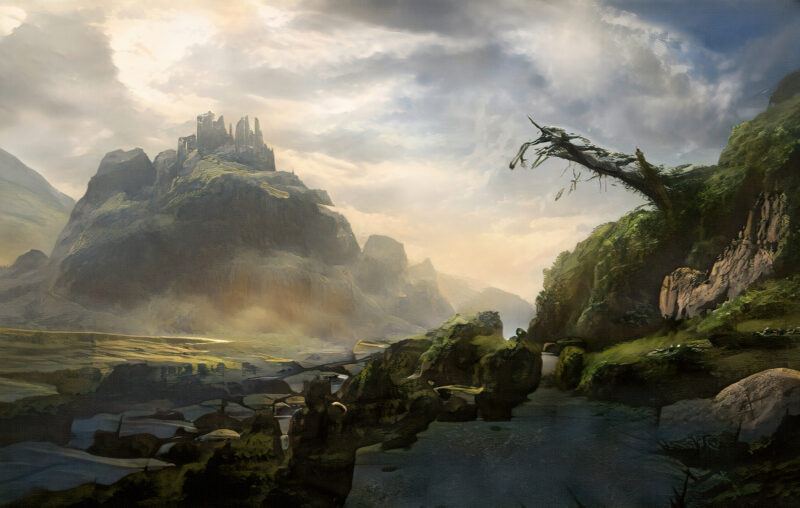An Art That Offers Choices

It takes a special kind of snobbery to say, as the film critic Roger Ebert did in 2005, that “video games can never be art.” I really do mean special: Ebert’s disdain for the new medium was of a very distinct and revealing kind. After considering a few potential counterexamples, he concluded he would never find “a video game that will deserve my attention long enough to play it.” Only a critic could achieve this sublime mixture of sweeping certainty with total incuriosity.
Ebert might as well have congratulated himself on never hearing about a painting good enough for him to consider looking at it. If you have never played a video game, you have never actually engaged with it in the manner appropriate to its form. Whether it is art or not is a subject on which you are thoroughly unqualified to opine. Ebert should have known better: his own art form of choice, after all, is one which famously suffered all manner of belittlement and disregard before the academy granted it the lofty status of “Art” with a capital A.
Cinema, wrote Max Horkheimer and Theodor Adorno in Dialectic of Enlightenment, “denies its audience any dimension in which they might roam freely in imagination.” Nobody would contest today that the director Martin Scorsese is an artist. But Scorsese recalls having to defend himself and his fellow filmmakers against the same aesthetes who now shower them with praise: “we stood up for cinema as an equal to literature or music or dance.”
Video games now have champions of their own. They have been featured in prestigious museum collections and defended in rousing thinkpieces. But plenty of cultural gatekeepers remain suspicious. Much is at stake on both sides of the debate: if any old dreck can be “art,” then the concept itself is cheap and meaningless. This has been a major problem ever since Marcel Duchamp called a urinal a sculpture. On the other hand, if we hold each new form to the standard of the one before it, we beclown ourselves by sniffing in this decade at work we will fawn over in the next.
Here, again, Ebert’s errors are instructive. “One obvious difference between art and games is that you can win a game,” he argues. Well, fine: one obvious difference between music and sculpture is you can hear music. They’re both art. Why does being “winnable” make something “not art” in Ebert’s estimation? It’s because a video game “has rules, points, objectives, and an outcome.” In this, just like those before him who faulted cinema for being too visual and not verbal enough, Ebert has accidentally hit on the secret of video games’ appeal. The fact that games have rules and structure doesn’t disqualify them from being art. It’s precisely what makes them our most exciting living art form.
I will fully concede: video games are highly structured. They can be repetitive, and this is one of the challenges against which designers have to work if they want to tell a fluid, organic story. Slashing down your 100th minotaur in God of War (2005) does not teach you anything about your character or his journey that you didn’t already know from slashing down the first one. Games also tend to have recurring structural features like levels, bosses, puzzles, and powerups. Fire up a new platformer, even a highly innovative one, and you are likely to recognize its basic elements from any number of similar titles.
But the conventionality of games isn’t in itself a strike against them. In fact, it’s what makes them stand out from older forms of art, which have become dissipate and amorphous in the wake of modernity. We are long past the days when it was shocking for James Joyce to write a “sentence” of 3,687 words or for Mark Rothko to bathe a canvas in pure color. The traditional rules and limits of the literary and visual arts have been so thoroughly exploded that innovation in them has no meaning any longer.
By contrast, gamers were riveted in 2005 by Indigo Prophecy (AKA Fahrenheit), whose storyline depended on players’ choices to a greater degree than had ever been tried. Each decision in the game led to outcomes and consequences, just like in real life. Those consequences determined how the narrative developed and concluded. There were kinks still to be worked out, but the medium was clearly advancing to new levels. “Despite its flaws, Indigo Prophecy is the definitive interactive story,” wrote one critic. “Not only does it perfect the genre, it redefines it.”
You can only “redefine” a “genre” if there are typical patterns it tends to follow—if its forms and conventions are understood and agreed upon by a community of artists and audience members. Virgil, Dante, and Apollonius of Rhodes are significant epicists because of how they modify, subvert, and repurpose the tropes of Homer’s masterworks. William Turner’s glowing landscapes are thrilling in part because of how they deviate from the sharp precision of masters like Nicolas Poussin and Claude Lorrain. When the free-form narrative techniques of Indigo Prophecy caught on in more polished games like Assassin’s Creed (2016), everyone could see that a new kind of storytelling was being born against the backdrop of an established tradition.
A persistent misapprehension of our era is that rules stifle creativity and betoken a lack of imagination. A highly stylized form like the sonnet seems intolerably artificial to us, as if imposed from the top down by fusty ideologues. In fact, though, sonneteers like Giacomo da Lentini and Francesco Petrarch chiseled the form out of ballads and folk songs, honing rhythms and rhyme structures which were already common practice. Contrary to the going assumption, structure often emerges organically in art out of popular demand.
People love rules and the cogency they enable. They are part of how we express the rational order we perceive in creation. And yes, of course those rules can gradually become calcified and oppressive—witness for example the stultifying rigor of late French Baroque drama. But without any conventions at all we become unintelligible to each other, which is how you end up with a $120,000 banana duct taped to a wall (Maurizio Cattelan’s Comedian, which inspired ridicule and incomprehension among all but the elect few who “got it”).
This dysfunction—the total breakdown of structure and the reduction of high culture to absurdity—now plagues almost every kind of art, from painting to poetry to music. For that matter, it plagues our politics and our communal life: we no longer agree on the meaning of America, the conventions of marriage and gender, or the importance and role of religion. This leaves us completely at sea and makes us look either ridiculous or evil to one another: we caricature each other as “blue-haired libs” or “white supremacist rubes” because we do not share even the most basic premises about who we are or what the rules should be.
Video games do not suffer from this problem. They are a creative form with rules and constraints. This makes both community and meaning possible. Gamers can team up across the globe, can celebrate the triumphs of their form, can experience the heights of elation and wonder that living art so often inspires, because they are working within a recognizable medium upon whose conventions they can build. The lyrical fairytale of Ico (2001), the melancholy parable of Braid (2008), the tense and fluid drama of Inside (2016): these achievements were hailed by gamers because they used the rules—and broke them judiciously—to convey moving and truthful accounts of the human experience.
There is a word for something which uses color, light, sound, and language to convey what it is like to live a human life: we call that art. It is a structured creation that expresses emotions and experiences which cannot be expressed in any other way. “The objects of imitation are men in action,” wrote Aristotle in his Poetics: events and the people who make them happen are the great subject of that elaborately symbolic communication called mimēsis.
This communication is what video games accomplish. Like all new forms, they achieve their particular kind of representation by new means, with new challenges and drawbacks—but also new possibilities. They have a kind of emotional immediacy which only holding a controller in your hands can provide. Try to play Resident Evil III (1999) without squealing in terror, or Final Fantasy VII (1997) without tearing up at least once. There is real visceral power here, and practically unlimited potential for growth. I wonder whether the same can be said at this point of cinema.
And like all art forms before them, video games are about more than mere entertainment. They foster new ways of looking at and acting in the world. They have unleashed powerful new energies that can be mobilized for both good and ill. Most importantly, and perhaps most appealingly for conservatives, games encourage respect for the laws of cause and effect which our politics so often seems to defy: what you choose to do in a game has consequences.
This is an antidote to the irrational and often arbitrary way in which honors are conferred and punishments meted out by our ruling classes. Many young people are tempted to view even our most hallowed institutions as surrealist jokes: the Dow Jones soars while jobs evaporate. State governors shutter small business while dining out at fancy French restaurants. And politicians call for “unity” while making lists of undesirables to shun. Over and against the despair this state of affairs provokes, games suggest that there is a real world in which real people can get real things done by developing skills and applying them. Thus despite the seeming hopelessness of the age, the gaming mindset is inspiring consequential endeavor and action in real life.
The GameStop stock drama this January, for example, was an instance in which community action online literally gamified the financial system. There are people who have taken the obsessive, repetitive energy of playing games like Minecraft and translated it into real-life discipline at the gym—if you can hack incessantly away at little pixelated trees, you can hack incessantly away at bicep curls.
Even the 2016 presidential election is acknowledged, by both its celebrants and its detractors, to have been shaped in no small part by internet communities of young people schooled in the digital language of memes. This language employs a huge vocabulary of video game references whose significance is taken as understood. In an era full of decline and dissolution, a generation hungry for meaning is finding that the digital world offers coherence and beauty unimpeded by postmodern skepticism. For this generation, no art is more urgent than video games.
The old guard of the art world, even those who fancy themselves highly “relevant,” are proving remarkably ill-equipped to recognize or comment upon these phenomena. In Glittering Images, an otherwise quite enjoyable survey of art history, Camille Paglia lumps video games in with “electronic billboards” and “sports telecasting.” Then she writes them all off as overstimulating drivel involving “dizzily swooping compressions and tunnel-like visions of space. The eye is assaulted, coerced, desensitized.”
Really? Has Paglia ever played a game through to completion? Certainly there are some titles which merit her critiques. But no one who has spent time with Final Fantasy XV (2016) could reasonably consider its artwork “dizzy” or “compressed”—in fact I challenge Paglia to find a landscape painter living who can match the sweeping grandeur of Tomohiro Hasegawa’s vast panoramas. Or else plunge into one of the long, meditative horseback rides in Shadow of the Colossus (2005): those woods are lovely, dark, and deep. There is no “tunnel-like vision of space” to speak of in either of these games; it is a mischaracterization so extreme that it can only be based on ignorance.
“Lord, what would they say / Should their Catullus walk that way?” asked W.B. Yeats in “The Scholars.” Theorists, at their worst, can only recognize what they’re used to. Really vital art doesn’t look to them like art because it doesn’t look like other things they’ve seen. What our own academicians are used to is disorder: the breakdown of convention, the unmaking of form. They do not realize that this once-rebellious attitude has become tired, empty, and drab.
The new art form, the one staring its opponents right in the face, is an art form of cohesion, community, tradition, and representation. It is part of a revolution in mores and behaviors that can help lead us out of the nihilism to which we have all fallen victim. Conservatives, if we’re smart, will take note.
Reprinted from Law & Liberty










